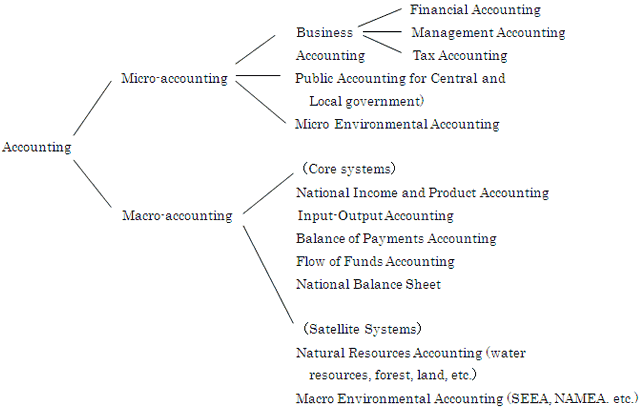Top>Education>Invitation to Macro-Accounting
 Index
Index

Yoshiaki Koguchi [Profile]
Invitation to Macro-Accounting
Yoshiaki Koguchi
Professor of Accounting, Faculty of Economics, Chuo University
1.Micro-accounting and macro-accounting
The Faculty of Economics at Chuo University offers a wide variety of accounting courses. This is quite rare even among all economic departments throughout Japan. One reason that these courses have been established is to cultivate fundamental academic ability required for the very tough CPA and Tax Accountant examinations. In each of the past three years, the number of our faculty students who passed the CPA exams was 20, 28 and 25, respectively. Moreover, it is remarkable that many of these successful examinees passed while they were still studying at university. Accounting courses designed to prepare for these examinations include the subjects grouped as micro-accounting as shown in the diagram below. Micro-accounting is an accounting field associated with corporations, municipal governments and other individual economic entities that constitute our society.
In addition to micro-accounting, our Faculty of Economics offers a course of macro-accounting theory. This course teaches students about the field of macro-accounting as shown in the diagram. Our faculty is probably the only economics department in all of Japan to offer such a course. Now, I am teaching financial accounting theory and macro-accounting theory at our undergraduate course and macro-accounting theory at the graduate.
The Faculty of Economics at Chuo University has spent many years for developing the academic culture which considers accounting to include the two major fields; micro-accounting and macro-accounting. This tradition has been gradually developed in the educational and research activities which highly appreciate the educational benefits of macro-accounting to understand the conceptual and realistic meaning of macroeconomics as well as micro-accounting. In this article, I would like to introduce our course in macro-accounting theory and to discuss the educational significance of the course for students.

2.What is macro-accounting?
Before introducing the contents of our course in macro-accounting theory, let me explain briefly the concept of macro-accounting to which I refer here. Macro-accounting treats an entire nation or a certain region as an accounting entity and measures the economic activities and the state of the natural environment within its entity. One of my research themes is water resource accounting which is expected to be useful information system for sustainable development of water resources. In this case, a watershed or a river basin is treated as an accounting entity. Since the international rivers such as the Rhine River, Danube River and Mekong River are running through several different countries, the entity of water resource accounting, in this case, is a watershed which is broader than a single country.
As shown in the diagram, macro-accounting can be divided into two groups. The first is a core systems group which contains the five systems from national income and product accounting to national balance sheet. National income and product accounting is closely linked to the field of macroeconomics which was established by John M. Keynes in his monumental work The General Theory of Employment, Interest and Money (1936). Other scholars who contributed to the development of national income accounting include British economists John R. Hicks and Richard Stone, Norwegian economist Ragnar Frisch, and American economist Simon Kuznets, all of whom won the Nobel Prize in Economics. In order to express this newly developing discipline, Hicks coined the term Social Accounting in his book The Social Framework: An Introduction to Economics (1942), because it is an accounting for society or an entire nation in the same way as business accounting is for individual company.
In 1953, the United Nations published a System of National Accounts (SNA) as a international standards for social accounting or national income accounting and recommended all member nations to develop the system as soon as possible. Since the beginning of 1940s, on the other, a series of important macro-accounting systems were developed, that is, Input-Output Accounting, Balance of Payments Accounting, Flow of Funds Accounting and the National Balance Sheet. It therefore became necessary to integrate such systems with SNA serving as the core. The UN, cooperated with international institutions such as the World Bank, revised the 53SNA in 1968 and in 1993. The 93SNA is an integrated and comprehensive system of five macro-accounting systems. Currently, UN member nations prepare macroeconomic data based on the 1993 SNA. In Japan, the SNA is referred to as national economic accounts and the Economic and Social Research Institute (ESRI) discloses annual and quarterly SNA data.
SNA is an essential source of information for diagnosing the economic condition of nation and for economic analysis, policymaking and research. The Japanese Statistics Act, which was amended in 2007, positions SNA as main statistics together with the national population census. The SNA was revised in 2008 in order to support the new economic environment. Currently, nations are working to ensure conformance with the new 2008SNA.
The other group within macro-accounting contains macro-environmental accounting and natural resource accounting which is related to sustainable development of natural resources such as water, forests and land. These systems provide information in physical as well as monetary terms which cannot be provided in SNA. They are named as satellite accounting which supplements SNA. Some representative macro-environmental accounting systems are the Integrated System of Environment and Economic Accounting developed by the UN, and the NAMEA by the Netherlands.
3.Goals of the macro-accounting theory course in our faculty
The main theme of macro-accounting theory course is to "study the structure of the United Nation's System of National Accounts (SNA) "and the three course targets are as follows;
- Improve the understanding of economic theory through fully understanding SNA and how to measure the important macroeconomic aggregates such as GDP, national income, consumption, investment, savings, balance of payments, etc..
- Stimulate students' interest in current topics and promoting their better understanding.
- Study newly developed macro environmental accounting and stimulate students' interest in environmental issues such as conservation of water, forest, land and biodiversity.
The course pays great attention to the relations with macroeconomics and other theoretical courses opened in our Faculty. The target of the lecture is not only to explain SNA itself but is to attract students' attention to a series of important economic indicators produced in the framework of SNA. This understanding contributes to the first objective of the lecture, which is to enable students to assess business cycles by using official statistical data. An understanding of macroeconomic indicators creates deeper understanding of economic theory, leading to a positive cycle in which students develop even more interest in macro-accounting. Fortunately, the majority of students in the Faculty of Economics has a good understanding of bookkeeping and financial accounting theory, and feels no difficulty of understanding the basic structure of SNA.
Secondly, I try to show the students recent news reported in newspapers almost every lecture. Students are shown how material studied in the class is related to their daily lives and to domestic/international economic affairs. In this spring term, for example, three papers in commercial journal discussed the effects of the Great East Japan Earthquake on Japanese balance of payment and government fiscal deficits were introduced and discussed.
Moreover, there are a variety of topics even focusing solely on the concept of GDP (gross domestic product), the most popular economic aggregate. Last year, China's GDP passed Japan to become second in the world. In contrast, economic disparity and environmental degradation are becoming severe and severe in China, thus leading to demonstrations throughout the country. This leads to the question of whether or not growth in GDP truly improves our economic welfare. Perhaps GDP is a worthless indicator, as once accused by crying "Ignore GDP" in the 1970s, worldwide. Some countries are trying to develop a GNH (gross national happiness) indicator instead of GDP. New happiness indicators have also been proposed by Nobel Prize-winning economists such as Stiglitz and Amartya Sen. In this way, the topic of GDP can stimulate students' interest in new economics and philosophy as the human security of Amartya Sen, which feature the central themes of overcoming poverty and starvation. The creation of such interest is another important objective of the lecture of macro-accounting theory.
The two points discussed above are mainly related to core systems. The third objective of my course is related to macro-accounting as a satellite system. Such systems are still in the early development and are not as firmly entrenched as core systems. However, macro-accounting focuses on many important topics challenged by the 21st century, including sustainable development of water resources, conservation of forests, and protection of biodiversity. Recent results of macro-environmental accounting are SEEA and NAMEA. The students in the Department of Public and Environmental Economics of our Faculty have highly conscious of environmental issues. I believe that macro-accounting theory course is very beneficial for such students as well.
4.The Faculty of Economics offers macro-accounting theory class both in undergraduate and graduate course
My current research topics are the formation of conceptual framework of accounting common to both micro-accounting and macro-accounting, as well as water resource accounting, land accounting and environmental accounting as macro-environmental accounting. Usually, the field of accounting is seen to be limited to micro-accounting and corporate accounting. However, the frontier of accounting can be expanded greatly by including macro-accounting in educational and research activities. Macro-accounting is also greatly stimulating the intellectual curiosity of students. I believe that the Faulty of Economics provides the perfect intellectual environment for freely conducting education and research based on the philosophy of viewing economy, society and the natural environment through micro- and macro-accounting perspective. We sincerely invite you to our Faculty of Economics at Chuo University, an institution which offers PhD program both in micro-accounting and macro-accounting.
- Yoshiaki Koguchi
Professor of Accounting, Faculty of Economics, Chuo University - Born in Tochigi Prefecture in 1948. Graduated from the Faculty of Economics at Chuo University in 1970. In 1976, completed the Doctoral Program at the Graduate School of Economics, Chuo University. Served as a Research Associate, Lecturer and Assistant Professor at the Faculty of Economics, Chuo University, before assuming his current position in 1987. Current research themes include fundamental theory common to both micro-accounting and macro-accounting, as well as water resource accounting, land accounting and environmental accounting as forms of macro-accounting. Major written works include "On the conceptual framework of accounting: micro-, meso- and macro-accounting perspective", in Accounting, (in Japanese, Moriyama Shoten, 2010), " Accounting publications and research in twentieth-century Japan," (Co-author, Richard Mattessich), in Two Hundred Years of Accounting Research, (Mattessich, R., ed. Routledge, 2008), Diversification of accounting systems and the conceptual framework of accounting (in Japanese, Co-editor, Masao Kawano, Chuo University Press, 2010), and Micro-Environmental Accounting and Macro-Environmental Accounting (in Japanese, Chuo University Press, 2002). Translation includes How Writing Came About, written by Denise Schmandt-Besserat (Co-editor, Ichiro Nakata, Iwanami Shoten Publishing, 2008).
- Research Activities as a Member of Research Fellowship for Young Scientists (DC1), Japan Society for the Promotion of Science (JSPS) Shuma Tsurumi
- Important Factors for Innovation in Payment Services Nobuhiko Sugiura
- Beyond the Concepts of Fellow Citizens and Foreigners— To Achieve SDGs Goal 10 “Reduce Inequality Within and Among Countries” Rika Lee
- Diary of Struggles in Cambodia Fumie Fukuoka
- How Can We Measure Learning Ability?
—Analysis of a Competency Self-Assessment Questionnaire— Yu Saito / Yoko Neha - The Making of the Movie Kirakira Megane








